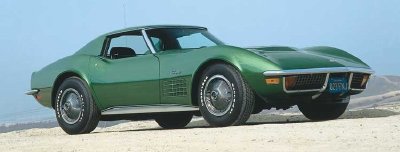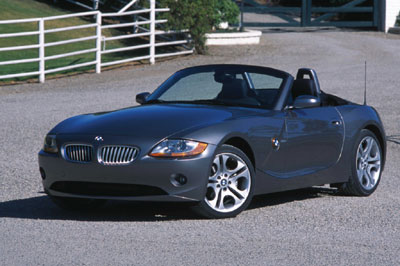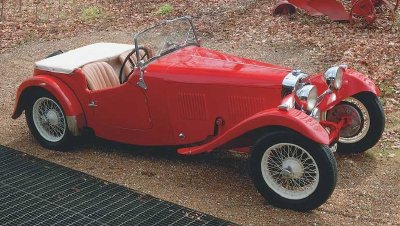
When the automobile sputtered to life in the late 1880s, the sports car wasn't far behind. Briggs Cunningham, the storied American sports-car builder of the 1950s, once declared that "in the beginning every car was a sports car, because they weren't practical or particularly useful on a day-to-day basis."
Then, starting in 1913, one Henry Ford made the motorcar itself universal by using a moving assembly line to crank out his simple Model T with unheard-of speed in unheard-of numbers. Competition and free enterprise did the rest. Soon, most anyone who wanted a car could afford one.
It was in this heady, fast-paced era of technical innovation and industrial growth that the sports car began to emerge as something beyond mere transportation. As pioneer American auto journalist Ken Purdy explained it: "The automobile had tremendous appeal for the sportsman of the [early 1900s]: It was the fastest vehicle at man's bidding, it was new, much about it was unknown. It offered a great challenge."
To the manufacturers, turning out perhaps a few score automobiles a year, racing was the best kind of advertising. Because it was a brand-new sport, the newspapers gave it extensive news coverage, and the manufacturer whose car won an important race on Saturday could be sure of a full order book the following Monday evening." In short, the first racing cars were also the first sports cars. They've been close cousins ever since.
Good or bad, the sports car evolved up to World War II as a creature mainly of Europe and England, not the U.S. Though motorsports remained very popular on both sides of the Atlantic, the topography and economic conditions "over there" tended to breed sportier cars with the defining attributes of quick acceleration, agile handling, and strong brakes. It seemed, that sports cars were thriving.
Then the Depression hit. Smaller companies perished, and the larger U.S. automakers adopted emergency survival measures -- none of which included sports cars. With the start of a terrible new world war, some thought the sports car as good as dead.
But the pundits were wrong again. Liberated by unpredecented prosperity in the early postwar years, some Americans began rejecting homegrown automotive values for cars that looked good and were actually fun to drive. Though no one knew it at the time, a revolution was underway. The sports car was about to captivate America as never before.
In the following pages, you will be able to trace the exciting history of sports cars, from their postwar boom to the present day. Along the way you will also find links to individual sports car profiles that offer history, specs, and photos. In addition, you can also read sports car reviews and browse through our sports cars by year and manufacturer.
We'll get started on the next page by learning about the sports cars of the 1940s.

After reading about all these great sports cars there's only one thing left to do -- buy one of your own and join the legacy. Here are reviews of some of Consumers Guide's favorite new sports cars:
Make/Model
The sports cars of the 1940s started innocently enough: just a few score GIs returning from World War II Europe with a foreign sports car in tow. The cars were mostly British and mostly ended up in the ritzier enclaves of the East Coast and California. Not much as invasions go but enough. The sports car had landed, and America would never be the same.
Featured Sports Cars of the 1940sFor most Americans in 1945, sports cars seemed as foreign as the people who drove them. Though Detroit had long offered jaunty rumble-seat models and even some snazzy two-seaters, only a small group of Yanks knew much -- or cared -- about the genuine sports cars available from England and Europe.
Not surprisingly, the cognoscenti tended to be well off, well educated, well traveled. They also tended to affect manners that made them "a race apart," as Ken Purdy described them. Purdy first met other U.S. sports-car devotees in the mid-1930s. To him they were a strange, secret society. "They spoke only to each other and in their native tongue," he wrote. " 'I shouldn't turn that much over five-thou, old boy; the big ends simply won't stand up to it.' They treated their mounts like newborn children."
Purdy relates being dumbfounded when he saw one worried owner heat "a gallon and a half of pure castor oil on a portable electric burner. He had a candy thermometer in the reeking stuff and he peered steadily at it. Just as it rose to the temperature he wanted…he snatched the instrument out, grabbed the kettle, and turned to me to say, 'Do stand aside, please; the oil mustn't cool before I get it into the engine.' "
Long enshrined as "the sports car America loved first," the MG seemed an unlikely object of desire in the land of Buck Rogers. Even MG's new TC roadster, introduced in late 1945, was just a mild evolution of the TA/TB design, which dated from 1936 but was conceptually rooted in the Twenties.
Love is one thing, commitment quite another. Although the TC and its cohorts won many American hearts, they didn't attract many U.S. sales. And they never would. Most Americans preferred the cars they already had and were primed for futuristic new models, which had been breathlessly forecast during wartime. Why, they wondered, would any sane person waste money on an old-fashioned thing like an MG?
Why, to make a statement, of course. As David E. Davis opined in 1970, sports-car enthusiasm in late-Forties America was an "easily defined protest movement…[P]eople were sufficiently fed up with the dumb cars coming out of Detroit to express their disgust by buying dumb imported cars…They were a hopelessly outgunned minority in the beginning, but they were a tough breed…driving cars that flew in the face of everything that Detroit, and thus America, stood for."

Little by little, sports cars became more common on U.S. roads and public interest grew. Of course, most any new car was of interest right after World War II, because Americans hadn't had any to buy for nearly four years. Domestic automakers mostly satisfied the huge pent-up demand with warmed-over versions of prewar fare, which was enough until about 1950. But most foreign automakers had been ravaged by war and desperately needed to export for dollars.
They, too, resumed production as quickly as possible, but began to realize that sports cars were making an impression in affluent America. Britain's Jaguar was among the first to capitalize on America's burgeoning sports-car "fad." It happened with the 1948 introduction of the all-new XK120, rightly hailed as the state of the sports-car art with its advanced twincam six-cylinder engine and sleek, modern styling.
Meantime, more and more U.S. dealers were starting to take up the sports-car cause. One was Max Hoffman, who bravely opened a toney New York showroom in 1946 to sell pricey French Delahayes, though he soon added more affordable cars, including Jaguars and MGs. Over the next 25 years, Hoffman introduced the U.S. to dozens of other foreign marques and models, notably the VW Beetle and the first Porsches.
In fact, Hoffman did more to grow the U.S. foreign-car market than anyone else except Kjell Qvale, who served the West Coast market from his San Francisco-based British Motor Car Distributors starting in 1947. That same year saw the first issue of a national magazine called Road & Track. Born of the "protest movement" Davis described, R&T also stimulated U.S. interest in foreign cars generally and sports cars in particular.
By the end of the 1940s, sports cars were definitely on the American scene, if not in many Americans' garages. Even Detroit could see something new and maybe important was going on. One can almost hear the boardroom debate: "Hey, maybe we ought to build our own sports car." "Heck, we can't make money with one of those." "Yeah, but it would sure bring in the customers, and that will make money."
The beachhead had been secured for a full-scale assault. Come the Fifties, a battalion of new models would charge into a booming U.S. economy and spread sports-car excitement from sea to shining sea.